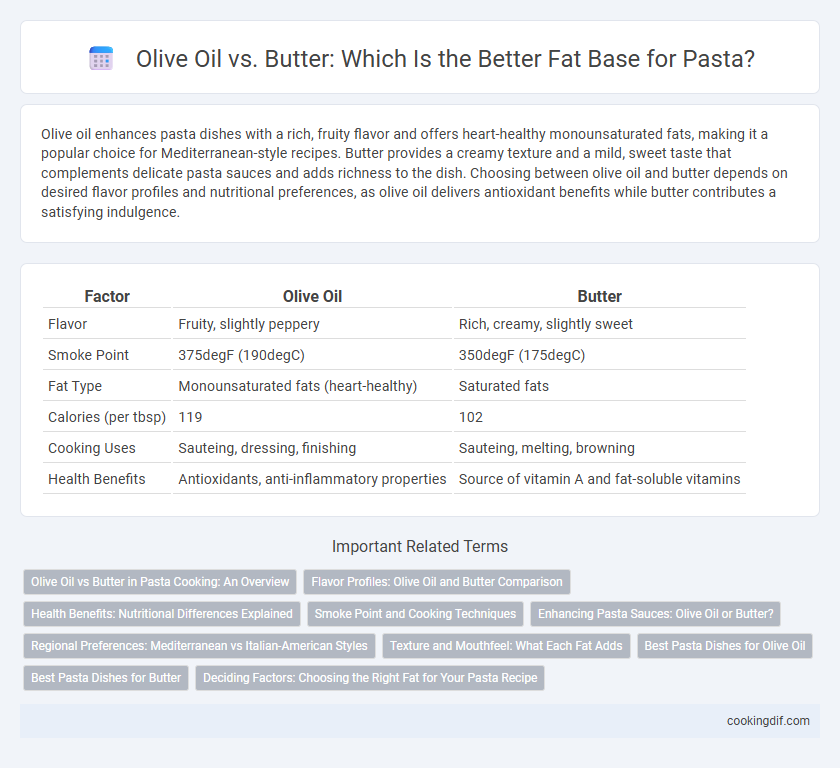Olive oil enhances pasta dishes with a rich, fruity flavor and offers heart-healthy monounsaturated fats, making it a popular choice for Mediterranean-style recipes. Butter provides a creamy texture and a mild, sweet taste that complements delicate pasta sauces and adds richness to the dish. Choosing between olive oil and butter depends on desired flavor profiles and nutritional preferences, as olive oil delivers antioxidant benefits while butter contributes a satisfying indulgence.
Table of Comparison
| Factor | Olive Oil | Butter |
|---|---|---|
| Flavor | Fruity, slightly peppery | Rich, creamy, slightly sweet |
| Smoke Point | 375degF (190degC) | 350degF (175degC) |
| Fat Type | Monounsaturated fats (heart-healthy) | Saturated fats |
| Calories (per tbsp) | 119 | 102 |
| Cooking Uses | Sauteing, dressing, finishing | Sauteing, melting, browning |
| Health Benefits | Antioxidants, anti-inflammatory properties | Source of vitamin A and fat-soluble vitamins |
Olive Oil vs Butter in Pasta Cooking: An Overview
Olive oil and butter serve as fundamental fat bases in pasta cooking, each imparting distinct flavors and culinary properties. Olive oil offers a fruity, slightly peppery taste with health benefits like antioxidants and healthy monounsaturated fats, making it ideal for lighter, Mediterranean-style sauces. Butter provides a rich, creamy texture and a sweet, nutty flavor that enhances traditional, creamy pasta dishes, though it contains higher saturated fats compared to olive oil.
Flavor Profiles: Olive Oil and Butter Comparison
Olive oil imparts a fruity, peppery flavor with slight bitterness, enhancing the freshness of pasta dishes, while butter offers a rich, creamy, and slightly nutty taste that deepens the overall flavor complexity. The choice between olive oil and butter as a fat base significantly influences the dish's aroma and mouthfeel, with olive oil providing a lighter, more vibrant profile and butter delivering a smooth, indulgent texture. Combining both fats can balance their distinct taste notes, creating a harmonious flavor depth ideal for various pasta preparations.
Health Benefits: Nutritional Differences Explained
Olive oil contains high levels of monounsaturated fats and antioxidants, which can reduce inflammation and support heart health, while butter is rich in saturated fats that may raise LDL cholesterol levels. Vitamins E and K in olive oil contribute to improved skin and bone health, contrasting with butter's higher content of vitamin A and saturated fat that can impact cardiovascular risk. Choosing olive oil as the fat base in pasta recipes enhances nutritional value by promoting better cholesterol profiles and providing essential nutrients for overall wellness.
Smoke Point and Cooking Techniques
Olive oil, with a smoke point around 375degF (190degC), is ideal for sauteing vegetables and finishing pasta dishes, enhancing flavor with its fruity aroma. Butter has a lower smoke point near 300degF (150degC), making it better suited for gentle warming, emulsifying sauces, and adding creamy richness without burning. Combining both fats optimizes cooking techniques by balancing high-heat stability and savory depth in pasta preparations.
Enhancing Pasta Sauces: Olive Oil or Butter?
Olive oil enhances pasta sauces with its rich, fruity flavor and beneficial monounsaturated fats, contributing to a lighter, Mediterranean-inspired dish. Butter offers a creamy texture and deeper, savory notes thanks to its milk solids, ideal for luxurious, rich sauces like Alfredo or brown butter sage. Choosing olive oil or butter depends on the desired sauce profile, balancing health benefits and taste preferences for the perfect pasta experience.
Regional Preferences: Mediterranean vs Italian-American Styles
Mediterranean pasta dishes predominantly use olive oil as the fat base, emphasizing lighter, heart-healthy flavors with hints of garlic and herbs typical of Southern Italy, Greece, and Spain. In contrast, Italian-American pasta often incorporates butter, contributing a richer, creamier texture seen in popular dishes like Fettuccine Alfredo and some variations of Carbonara. These regional preferences highlight the traditional Mediterranean focus on fresh, simple ingredients, whereas Italian-American cuisine leans toward indulgent, butter-infused sauces.
Texture and Mouthfeel: What Each Fat Adds
Olive oil lends pasta a smooth, slightly silky texture with a light, fruity mouthfeel that enhances the overall freshness of the dish. Butter provides a rich, creamy texture that creates a velvety mouthfeel, adding depth and indulgence to the pasta. The choice between olive oil and butter significantly influences the tactile experience, with olive oil boosting brightness and butter amplifying richness.
Best Pasta Dishes for Olive Oil
Olive oil enhances pasta dishes with a rich, fruity aroma and a heart-healthy profile, making classics like aglio e olio and puttanesca stand out for their vibrant flavors. It pairs exceptionally well with fresh herbs, garlic, and chili flakes, delivering a lighter, more Mediterranean taste compared to butter's creamy richness. Using extra virgin olive oil boosts antioxidant intake, which complements pasta recipes centered on vegetables, seafood, and light sauces.
Best Pasta Dishes for Butter
Butter provides a rich, creamy texture and subtle sweetness that enhances the flavor of classic pasta dishes like Fettuccine Alfredo, Carbonara, and Cacio e Pepe. Its ability to create smooth, velvety sauces makes it the preferred fat base for recipes requiring a luxurious mouthfeel and delicate taste. Pasta tossed in butter perfectly complements delicate herbs, garlic, and cheeses, delivering a comforting, indulgent dining experience.
Deciding Factors: Choosing the Right Fat for Your Pasta Recipe
Olive oil enhances pasta dishes with a rich, fruity aroma and heart-healthy monounsaturated fats, making it ideal for Mediterranean and lighter recipes. Butter delivers a creamy texture and a slightly sweet, nutty flavor, which works best in rich, comfort-food pasta sauces like Alfredo or carbonara. Consider the desired flavor profile, health benefits, and sauce consistency when choosing between olive oil and butter as the fat base for your pasta.
Olive oil vs butter for fat base Infographic

 cookingdif.com
cookingdif.com